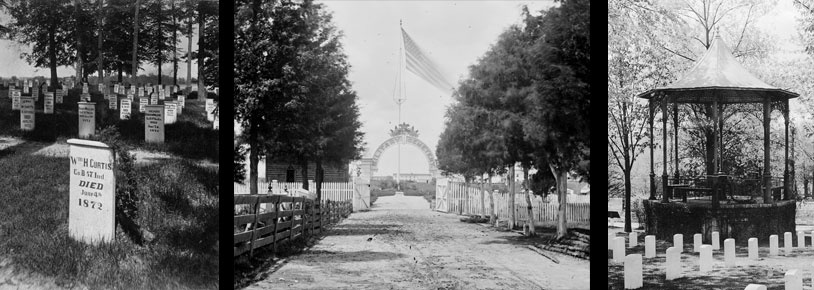

Civil War Era National Cemeteries: Honoring Those Who Served
Poplar Grove National Cemetery
Petersburg, Virginia
 |
Superintendent's Lodge, Poplar Grove National Cemetery Courtesy of the National Park Service |
After unsuccessful attempts to directly assault and capture the Confederate capital of Richmond, Union General Ulysses S. Grant devised a new strategy to slowly choke the city. The new target became the town of Petersburg, 25 miles south of Richmond and an important supply center for the capital. After a series of fruitless attacks on Petersburg in mid-June of 1864, Grant adopted a strategy to surround Petersburg and methodically cut the rail and road supply lines feeding Richmond. For ten months, Union soldiers set in trenches around the town and fought the Confederate forces holding Petersburg. Sniper fire, light artillery engagements, and mortar shelling filled the days as Grant’s men gradually wore down the thinly stretched Confederate defense.
In mid-March 1865, Confederate General Robert E. Lee ordered a surprise attack against the Union at Fort Stedman at the western side of Petersburg. Considered Lee’s last grand offensive move of the war, the attack failed. On April 1, 1865, Union forces routed a Confederate defense at Five Forks and gained control of the last rail line from Petersburg to Richmond. This final blow forced Lee to retreat, abandoning both Petersburg and Richmond. A week later Lee surrendered in Appomattox, Virginia.
In the wake of the Civil War, the U.S. government established numerous national cemeteries in Virginia at the site of intensive battles and other engagements. In 1866, the Army’s Office of the Quartermaster General selected a site for a cemetery to hold the remains of Union soldiers who died during the siege of Petersburg. The site selected was a former Union camp south of Petersburg. The 50th New York Engineers built the camp in October 1864, which consisted of a central parade ground surrounded by barracks, officers’ quarters, and the Poplar Grove Church.
After the war, most of the old camp buildings were removed and remains were brought from sites around the Petersburg area. By 1867, nearly 5,200 burials lie in the Poplar Grove National Cemetery.
|
1893 Site Plan of Poplar Grove National Cemetery |
Beginning in 1871, the federal government implemented a series of improvements for the cemetery, including the cemetery’s brick enclosure wall and iron gates, marble headstones for the graves, and the erection of a superintendent’s lodge near the cemetery’s entrance. The lodge is a one-and-one-half story brick building in the Second Empire style, notable for its mansard roof and dormer windows. The lodge’s design is of a standard plan created by Quartermaster General Montgomery C. Meigs, and is one of the 17 remaining Second Empire-style Meigs lodges found at the Civil War era national cemeteries.
Additional improvements at Poplar Grove National Cemetery included the construction of an iron rostrum (1897) and restrooms and maintenance facilities (1929). In 1915, a tornado swept through the cemetery, destroying 139 trees. Many of these trees were replaced during the 1930s. In 1933, the appearance of the cemetery was radically altered when the upright headstones were laid flat into the ground in order to facilitate landscape maintenance.
In 1957 the government officially closed Poplar Grove National Cemetery to interments. Since that time, little has changed to the physical landscape within the cemetery. In 1991, the National Park Foundation purchased roughly four acres west of the cemetery in order to provide a small space for parking and to serve as a wooded barrier as residential growth encroaches upon the cemetery property.
| Plan your visit |
Poplar Grove National Cemetery, a part of Petersburg National Battlefield, a unit of the National Park System, is located at 8005 Vaughan Road in Petersburg, VA. For information on visiting the cemetery please see the National Park Service Petersburg National Battlefield website or call the park’s visitor center at 804-732-3531. While visiting, be mindful that our national cemeteries are hallowed ground and be respectful to all of our nation’s fallen soldiers and their families. Additional cemetery policies may be posted on site. The cemetery is one of four components of the national battlefield, a unit of the National Park Service. The Eastern Front Visitor Center in Petersburg introduces the siege of Petersburg and its impact of the war. Other components of the park include General Grant’s Headquarters at City Point in Hopewell, and the Five Forks Battlefield in Dinwiddie. The National Park Service’s American Battlefield Protection Program provides a brief summary of the Siege of Petersburg. Additional information on the battle is available from the Civil War Preservation Trust. Poplar Grove National Cemetery is one of seven national cemeteries in the Richmond area. The others include: Fort Harrison and Richmond National Cemeteries in Richmond; Seven Pines National Cemetery in Sandston; Cold Harbor National Cemetery in Mechanicsville; City Point National Cemetery in Hopewell, and Glendale National Cemetery in Richmond. |
